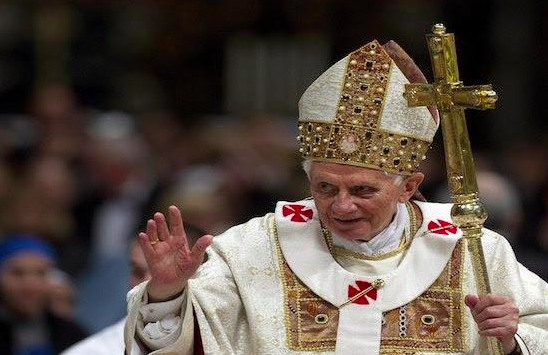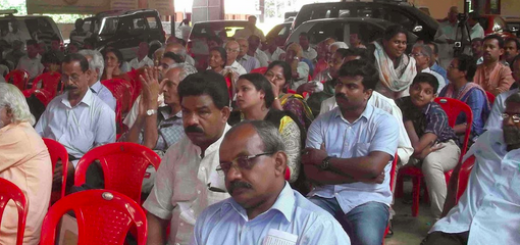SYNODALITY IN CHURCH!

(In the pic: A file photo of then Pope Benedict XVI blessing the faithful at St. Peter's Basilica, Vatican City. Benedict XVI resigned as pope on Feb. 28, 2013). People-of-God, Equality in community is Synodality, Church, not Hierarchy! Reform in the Church comes out of genuine synodality In Lacroix by Martin Madar, 17 Feb.2020.
What is the Church? A pyramid ruling from the top with ‘DIKTATS’ or serving from the bottom? It is neither, but both! How?
In the beginning it was serving from the bottom – Jesus washing the feet – and healing from the thick of the crowd, power going out of Him to heal the woman affected with flow of blood. So he was both diving to the bottom to serve the least and in the midst of the crowd to heal those affected with bodily and spiritual infirmities – Blind Bar Thimeus and woman caught in adultery are just two of the many examples!
Constantinian Church!
With the advent of Constantine, Church became top heavy, a Pyramid ruling from the top. It continued to be so till the resignation of Benedict XVI. With the advent of Francis, Church is struggling to come up from the bottom and find equality and level ground at the Sea-top, where there is no ups and downs, only level space where boats can float and sail smoothly.
Francis’ Church!
As of today Francis has succeeded ONLY little to extricate his head aided by German bishops from the heavy weight of the Constantine pyramid. This small success is called the Amazone Synod acclaimed by the whole world. This is now neutralized by the roaring criticism from conservatives. It has forced him to bring out his post-synodal exhortation staying silent for or against the success part, to prevent a Schism by providing hope for conflicting factions. Thus an uneasy calm in the rocking of the boat is achieved, but with no tangible gain.
Calmed the Storm!
What Francis has achieved is to CALM DOWN the roaring storm rocking HIS BOAT to sinking, recall the Biblical incident! This is well analyzed by the French daily La Croix writer Martin Madar. Copious excerpts from his article on SYNODALITY are given below for further reflection and clarification. Please read them below. james kottoor, editor ccv.
Please read below excerpts from Martin Madar’s article in La Croix
Francis' desire that the Church become truly a synodal institution is his most important initiative, actualizing the idea that the Church is not the pope and vice versa….Benedict’s resignation had the potential to bring the papacy down from its "pyramid-like isolation" and situate it within the church where is its proper place.
Benedict's resignation opened a space for Catholics to rethink how they understand themselves as Church….From day one of his pontificate, Francis has been inviting his fellow bishops to be genuine pastors, and not always wait for Rome to tell them what to do.
Francis' desire that the Church become truly a synodal institution is his most important initiative, actualizing the idea that the Church is not the pope and vice versa…The responsible person/s in the churcn are not only of the pope and the bishops but also of everyone in the Church….
Synodality emphasizes that being a Christian is rooted in the baptismal call and that all the baptized ought to see themselves as agents of the Church's mission. After centuries of centralization of power in the papacy and inflating of the Petrine office, Benedict's stepping down could be seen as an invitation to the whole Church – the laity and the hierarchy – to assume their responsibilities for what the Church becomes and for the difference it is supposed to make in the world.
This opportunity to renew and reform the Church is real, especially since it has a strong advocate in Benedict's successor, Pope Francis. From day one of his pontificate, Francis has been inviting his fellow bishops to be genuine pastors, and not always wait for Rome to tell them what to do. In this, and in many other ways, Francis has been releasing the bold vision of Vatican II from captivity, as one theologian put it aptly.
Francis' desire that the Church become truly a synodal institution is his most important initiative, actualizing the idea that the Church is not the pope and vice versa. During the first seven years of his pontificate, he has already convoked four synodal gatherings and, in contrast to his predecessors, tried to make them real assemblies.
It seems clear that for Francis it is of utmost importance that the whole Church take part in the process of discernment guiding it in its mission to give witness to the Gospel. This is the responsibility not only of the pope and the bishops but also of everyone in the Church.
Synodality, as Francis has been promoting it, brings to the fore several key elements of Vatican II's ecclesiology. It emphasizes that being a Christian is rooted in the baptismal call and that all the baptized ought to see themselves as agents of the Church's mission.
Synodality promotes the idea of a dialogical Church, since synodality is essentially a process of mutual listening and learning that should take place at every level in the Church.In this way, synodality also affirms the full theological reality of the local Church. It invites churches in their particular circumstances to discern the signs of the times and address them in light of the Gospel.
Unfortunately, only a few individual bishops and bishops' conferences have followed Francis in promoting synodality within the sphere of their pastoral charge.Perhaps most bishops are more comfortable to exercise their ministry from the perspective of the Church as a pyramid, on top of which they reside. Very little dialogue and consultation is needed.
They may see synodality as a dreadful vision of the Church that is governed by a committee for which they have no use, as one critic of synodality recently noted. Some bishops may be most comfortable executing a directive that comes to them from above, but they may be less prepared to exercise creative, Spirit-discerning leadership.
Solitary Example!
Bishop Robert McElroy of San Diego stands out as an exception in this. In the fall of 2016, he held a diocesan synod on the implementation of key pastoral insights of Pope Francis' exhortation "The Joy of Love" (Amoris Laetitia). Since then, he has become the foremost promoter of synodality in the United States.
Recently McElroy argued that to move forward from the crises it currently experiences, the Catholic Church in the United States "should embrace the type of synodal pathway" used by the Church in the Amazon region.
So far, the boldest and most systematic action toward responsibility for its future comes from the Church in Germany. There the Catholic Church embarked on a two-year synodal path. The process began last December, and for the next two years delegates from among the bishops, priests, religious, and the laity will engage in dialogue.
There are four main topics: power in the church, priestly celibacy, the place of women, and sexuality. As one can imagine, some conservatives are raising alarms, warning of schism and further demise of the Church in Germany.One thing is certain, however. If genuine synodality takes place, there will be changes – likely very significant – in Catholic self-understanding and practice.
Seven years later, the opportunity for the Church that opened with Benedict XVI's resignation remains largely unrealized. It is not evident what Pope Francis can do to communicate more clearly to fellow bishops his openness to shared governance.The need for Spirit-filled leadership is dire. The whole Church needs to be engaged in its reform and renewal so that it can witness before the world God's saving love. (Martin Madar teaches theology at Xavier University in Cincinnati, Ohio, Lacroix international, describes itself as the “World’s Primier Independent Catholic daily!).

















If you desire protestantism there are thousands of so called ‘’churches” to choose from. If you seek the truth there is only one true Church in which to find it. Those “Catholics” desiring to destroy the Church from within appear not have a grasp of history and the destructive nature of the deviance spawned by Luther and his company of heresiarchs. Or perhaps they do as they are intent upon their satanic master’s paganizing business.
There is not and cannot be a “Catholic Reformation Movement”. Such a thing is oxymoronic.